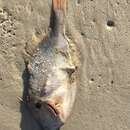Diagnostic Description
provided by Fishbase
Pelvic terminus always absent; head and body with numerous small round orange or orange-yellow spots; lips often blackish (Ref. 13442).
- Recorder
- Cristina V. Garilao
Life Cycle
provided by Fishbase
Distinct pairing (Ref. 205).
Morphology
provided by Fishbase
Dorsal spines (total): 2; Dorsal soft rays (total): 32 - 39; Analspines: 0; Analsoft rays: 35 - 41
- Recorder
- Cristina V. Garilao
Trophic Strategy
provided by Fishbase
Usually found over bottoms with seagrass, sand, or mud (Ref. 3790). Juveniles are associated with floating Sargassum. Solitary or in pairs (Ref. 9710). Feeds on a variety of plants, including algae and seagrasses (Ref. 3790).
Biology
provided by Fishbase
Usually found over bottoms with seagrass, sand, or mud (Ref. 3790). Juveniles are associated with floating Sargassum. Solitary or in pairs (Ref. 9710). Feeds on a variety of plants, including algae and seagrasses (Ref. 3790). Generally considered as trash fish, rarely consumed (Ref. 3790). Traded as an aquarium fish at Ceará, Brazil (Ref. 49392).
Importance
provided by Fishbase
fisheries: subsistence fisheries; aquarium: commercial
Comprehensive Description
provided by Smithsonian Contributions to Zoology
Aluterus schoepfi (Walbaum)
The findings were the same as for A. heudeloti. In the smaller specimen (57 mm SL), A 2α has relatively larger dorsal extent than in any other Aluterus examined, the posterodorsal fibers almost reaching the infraorbital ligament.
- bibliographic citation
- Winterbottom, Richard. 1974. "The familial phylogeny of the Tetraodontiformes (Acanthopterygii: Pisces) as evidenced by their comparative myology." Smithsonian Contributions to Zoology. 1-201. https://doi.org/10.5479/si.00810282.155
Aluterus schoepfii
provided by wikipedia EN
Aluterus schoepfii, the orange filefish, is a species of fish in the family Monacanthidae. The species can also be listed under the family Balistidae. They can reach a maximum size of 62 centimetres (24 in) although they are common to 40 centimetres (16 in).[2]
Characteristics
Orange filefish can be distinguished by the presence of 2 dorsal spines and 32-29 dorsal soft rays. They do not have anal spines but have 35–41 anal soft rays. The pelvic terminus is absent, the body has numerous small round orange or orange-yellow spots, and the lips are often blackish.[3]
Distribution
Orange filefish are distributed along the Western Atlantic. This includes Nova Scotia, Bermuda, and the northern Gulf of Mexico to Brazil. Distributions along the Eastern Atlantic include Cape Blanc and Mauritania to Angola.[3]
Environment
Orange filefish are benthic fish distributed in a depth range of 3 to 900 metres (10 to 2,953 ft). They are subtropical, found between 46°N and 33°S latitudes.[3] [4]
Habitat
These fish are usually found solitary or in pairs over sea bottoms with sea grass, sand, or mud. Juveniles can be found associated with floating Sargassum.[3]
Feeding
Orange filefish feed on a variety of aquatic vegetation, including sea grasses and algae.[3]
Importance to humans
Orange filefish are considered trash fish and rarely consumed by humans. In Brazil these fish are traded as aquarium fish. These fish contain a poison (ciguatoxin) in their flesh, which may cause ciguatera poisoning if eaten.[3]
Similar species
The dotterel filefish is similar to the orange filefish, although the dotterel filefish has a longer tail fin and no orange spots along the body. The orange filefish differs from other triggerfishes by having only 2 dorsal spines.[2]
References

- license
- cc-by-sa-3.0
- copyright
- Wikipedia authors and editors
Aluterus schoepfii: Brief Summary
provided by wikipedia EN
Aluterus schoepfii, the orange filefish, is a species of fish in the family Monacanthidae. The species can also be listed under the family Balistidae. They can reach a maximum size of 62 centimetres (24 in) although they are common to 40 centimetres (16 in).
- license
- cc-by-sa-3.0
- copyright
- Wikipedia authors and editors
Diet
provided by World Register of Marine Species
Feeds on a variety of plants, including algae and seagrasses
North-West Atlantic Ocean species (NWARMS)
- license
- cc-by-4.0
- copyright
- WoRMS Editorial Board
Distribution
provided by World Register of Marine Species
Atlantic and Gulf of Mexico coasts of the United States, Bermuda, Bahamas, and Brazil, not uncommon in summer as far north as Cape Cod; reported to Portland, Maine and Halifax Nova Scotia
North-West Atlantic Ocean species (NWARMS)
- license
- cc-by-4.0
- copyright
- WoRMS Editorial Board
Habitat
provided by World Register of Marine Species
usually found over bottoms with seagrass, sand, or mud
North-West Atlantic Ocean species (NWARMS)
- license
- cc-by-4.0
- copyright
- WoRMS Editorial Board
Habitat
provided by World Register of Marine Species
benthic
North-West Atlantic Ocean species (NWARMS)
- license
- cc-by-4.0
- copyright
- WoRMS Editorial Board

